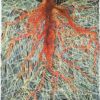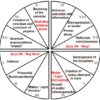The contemporary cosmological narrative is linked to a traditional symbolic representation of the whole. The number, in the qualitative sense, allows a link between the physically knowable reality and the imaginary World-Soul. Thus, the quaternary is reflected in four fundamental cosmological events, two of which are of the simple attractor type with the other two characterized by strong emergence. The ternary is revealed through a three-moment dialectic, chiseled into the cosmic becoming by the fundamental forces of physics. The reflections of these two archetypal numbers thus offer another glimpse of the universe and, from a perspective between different orders of reality, may also offer food for thought about certain new relationships between cosmological events.






